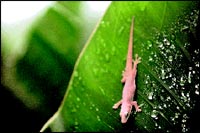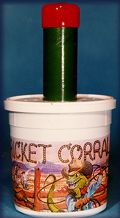Articles
IDEAS
WHATEVER...
Scientists get a grip on gecko's secret
Stephen Humphries
BERKELEY,
CALIF
A new scientific discovery about geckos has scientists climbing up the walls:
Researchers have concluded that the lizards utilize subatomic molecular
attraction to shimmy their way up vertical surfaces.
The key to geckos' cling lies in millions of microscopic hairs, called setae,
that line their feet. A single hair can support the weight of an ant, thanks to
forces of attraction resulting from interactions between the positive and
negative charges of protons and electrons.
Cameras took 1,000 pictures a minute to help analyze the motion of geckos'
feet. It was discovered that the geckos uncurl their toes slightly, which allows
them to unstick the hairs on their feet - in much same the way that one peels
tape off a surface.
 |
| ERIC
RISBERG/AP 
|
Researcher Robert Full of Berkeley University in San Francisco, envisions
adapting the geckos' secret for technological uses. "One could develop a
general dry adhesive that stays clean. It would be velcro which doesn't require
two pieces," he says in a telephone interview. If scientists successfully
find a way to replicate these atomic forces, then such an adhesive could even be
used underwater or in space.
The research was funded by IS Robotics Inc. The company has since copied the
gecko's toe motion to develop a robot prototype that is able to climb walls
(though not as fast as the reptiles) with pressure-sensitive glue adhesive on
the machine's "feet."
Geckos are nature’s
little hit men
LARRY Manetti, the former "Magnum P.I." co-star, is working
on a book about life behind the scenes of the show. I was flipping through an
uncorrected proof of it with our entertainment writer Tim Ryan last week,
hooting at some of his memories.
Hooting, because some of them are pretty wild, like when he describes the
waters around Oahu as simply teeming with sharks. Manetti says that once, during
a scene in the ocean with Tom Selleck, he was brushed by a 20-something-foot
shark.
Maybe Manetti did have a close encounter with a shark, but it seems odd that
about 30 pages later, he admits he made up an almost identical shark story for a
national gossip newspaper.
One story I don't think he made up was that the one in which he rented a
beachfront house for several thousand dollars a month, but moved out after a
large cane spider came walking in through an open doorway. He and his wife
simply could not live in a place infested with spiders the size of your hand.
It doesn't matter that cane spiders generally end up inside houses by
accident and infrequently at that. What matters is that many people from the
mainland can't understand what it's like to live in a place where the outdoors
are sometimes indoors.
I have heard stories of college athletes who have quit the University of
Hawaii and returned home after seeing one good-sized cockroach. I've had
visitors reel back in horror at the sight of a run-of-mill gecko scurrying
across the wall.
And I have to admit, the first time my brothers and I saw termites swarming
around our house back in high school we freaked out, believing the end of the
world was at hand.
NOW, I view geckos as a vital part of my household ecosystem. Sure, they poop
all over the place, but they gobble up bugs left and right. If we didn't have
geckos, someone would try to invent self-propelled, miniature, insect-tracking
and elimination robots which couldn't do the job as well or as stealthily as
geckos.
What we don't realize is that the rest of the country isn't like us. Houses
are supposed to be hermetically sealed environments where anything that moves --
other than pets or humans -- is an unwanted alien intruder.
There are some places like that in Hawaii, but I haven't been in many of
them. Instead, most of us have reached a level of detente with local wildlife
that generally allows for peaceful co-existence, as long as the critters don't
abuse the privilege.
For instance, one or two ants on the counter are expected. A line of 3,000
ants leading from the garage to the dog dish is a no-no.
Geckos who hide behind wall-hangings and only come out to snap up mosquitoes
and other non-A-list insects are OK. Geckos who crawl across your back at night
while you sleep get free airfare to the back yard.
Roaches the size of rubber slippers and, yes, Mr. Manetti, cane spiders,
should be reminded that they are to remain outdoors. Those who do intrude,
either on purpose or inadvertently, must be made an example of and dispatched
with a severity so swift that it sends an unmistakable message to the rest of
their species.
Centipedes, however, are a special case. Centipedes are mean, sneaky and
heavily armed. They are to be wiped out wherever they may be found. If one
enters the premises, then you must search out its relatives outside and
prosecute them fully, with malice aforethought, extreme prejudice and, if handy,
a machete.
Insect Dispenser for
Lunching Lizards
Dishing Up Crickets
By Teresa Riordan
ABCNEWS.com Patent Columnist
What’s the yummiest, most nutritious meal for the average
reptile? Crickets. They’re chockful of calcium and protein and other good
things.

When
the snake wants a snack, reach for the Cricket Corral (Pet Tech) |
Plus, they are inexpensive, which makes them the meal
of choice for anyone who happens to have a pet snake or a frog or a lizard.
Indeed, they are so popular that most pet stores sell
from 8,000 to 10,000 of them a week.
Problem is, crickets are just so icky. You have to buy
them fresh from the pet store every other day or so. (Reptiles are finicky
eaters—no dead crickets, please.)
And every time you open the container to give your
sweet little gecko a treat, there’s the chance that of few of those crickets
will go AWOL, leaping to some nether region of the house so they can wake you at
2 a.m. with their boastful, nose-thumbing chirps.
Pez Dispenser
for Crickets
Darby Cunningham and David Rose recently received U.S. patent 5,630,374 for a
device that they say turns reptile feeding into an orderly, nontraumatic affair.
Think of it as a Pez dispenser for crickets.
Essentially, it’s a plastic container with a 9-inch-long tube sticking out of
the top. The idea is that you put a few dozen crickets inside the container,
place the cover on top and then stick in the tube, which is capped with a top
that has tiny air holes punched into it.
Pretty soon, all of the crickets will have climbed up
into the tube, and you won’t see any in the container itself.
“We took advantage of the natural instincts of a
cricket—which is to climb and hide in a dark place,” Rose says.
The inside of the tube has an “attractive dark
interior,” Rose’s patent notes, that is rough in texture so crickets hang on
easily.
Icky No Longer
When your bearded dragon gets a cricket craving, pull the tube off and shake out
a few critters.
“You just give it a little tap and they begin to fall
out,” Rose says.
The hungrier your pet, the more you tap. When you’re
done, insert the tube back into the container.
Produced by Pet Tech of Van Nuys, Calif., the Cricket
Corral retails for about $7. It features pictures of cowboy lizards lassoing and
branding crickets.
So far, the Cricket Corral is especially popular among
mothers, Rose notes.
“Moms can be squeamish about dealing with them,” he
says. “But with this, you don’t have to touch them at all.”
|
Some
Basic Gecko Genetics (Page 1)
This article will (hopefully) provide the reader with an understanding
of some very basic gecko genetics as they relate to breeding. Note that I
said basic genetics; These examples contain no biological
explanations, just the facts. I am not a biologist, however the
information provided is a result of a combination of my education and
experience.
The easiest way to present this overview is through photo examples. The
following examples will use one of the most popular gecko breeding
projects, the leucistic leopard gecko.
|
|
|
|
|
|
 |
|
|
|
|
|
|
|
|
|
|
|
|
|
|
 |
|
|
|
|
|
|
|
This
is the normal phase |
|
|
|
|
|
|
|
|
|
This
is the so-called leucistic phase |
|
Some
Basic Gecko Genetics (Page 2)
Let's say the normal phase gecko on the left is a female. That would
leave the leucistic gecko on the right; Let's say that this one is a male.
If you placed this pair together, and they bred successfully, the
female may lay 3 sets of two eggs. A total of six eggs, but to keep this
simple, let's say that the female only laid one set of two eggs. All of
the offsping from this pair will be heterozyguos for leucistic. This means
that each baby will carry the gene for the leucistic trait, but will
appear normal to the eye. These babies would be called "Hets"
|
|
|
|
|
 |
|
|
 |
|
|
 |
 |
|
|
|
|
|
|
+ |
= |
|
|
|
|
|
|
|
|
(Hets) |
|





|

